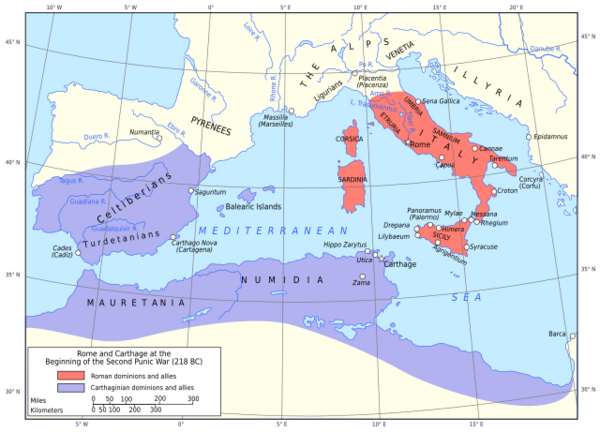The Second Punic War
The Second Punic War (218-201 BC) was a conflict between Rome and its rival state Carthage. In a struggle for existence, the two major powers in the Mediterranean at the time fought in several theatres, with both sides inflicting significant defeats on the other. After coming as close as it had to destruction since its sacking by the Gauls in 390 BC, Rome fought off Carthage in Italy and managed to drive her out of Spain. After a series of battles in Africa, Rome eventually stood victorious. However, the war saw many changes in fortune and remains one of the hardest-fought wars in the history of the Roman Republic.
The Causes of the Conflict
After Carthage's defeat in the First Punic War in 241 BC, it lost two significant possessions in the Mediterranean. First, as part of the Roman peace terms, it surrendered the possession of Sicily. And second, after just three years of peace, Rome took advantage of Carthaginian in-fighting and seized Sardinia. This latter action was seen as unjustified and caused significant resentment among the Carthaginians. However, in addition to this, many Carthaginians, such as Hamilcar Barca, were not prepared to accept the outcome of the First Punic War as final. Hamilcar laid the foundations for a new war started by the Carthaginians to re-establish Carthaginian power in Spain. Before his death, Hamilcar passed this animosity on to his son, the famous Hannibal.
Hamilcar died in 229 BC, and after his son-in-law, Hasdrubal succeeded him; a final treaty with Rome was made. It was about the river Ebro, and the treaty of 226 BC made it the northern limit of Carthaginian power in Spain and, as such, the southern limit of Roman interest. This treaty contained the seeds which would blossom into the Second Punic War. Rome had previously concluded an alliance with Saguntum, which lay south of the Ebro. And while Rome was to claim that this alliance overrode the Ebro treaty, Carthage saw the Ebro treaty as a sign that they could do as they pleased, including waging war against Sagunutum.
Hannibal succeeds his brother-in-law in 221, and by 220, the Saguntines request help from Rome, expecting an invasion to be imminent. The Senate thus sent out emissaries to both Carthage and Hannibal directly. However, Hannibal was eager for a conflict with Rome, and the Senate was confident it could limit the conflict with Carthage to Spain. After Hannibal sacked Saguntum in 219 and after a brief internal dispute in the Senate, Rome declared war on Carthage. Unbeknownst to the Senate, which never envisaged that the war might come to Italy, it thought itself still having the initiative. However, the ensuing war was fought in Spain and Italy. While both arenas of war were operating simultaneously, blending into the other, it's easiest to follow events when one divides the two into different narratives.
Read on: The War in Italy
MLA Citation/Reference
"The Second Punic War". HistoryLearning.com. 2025. Web.

